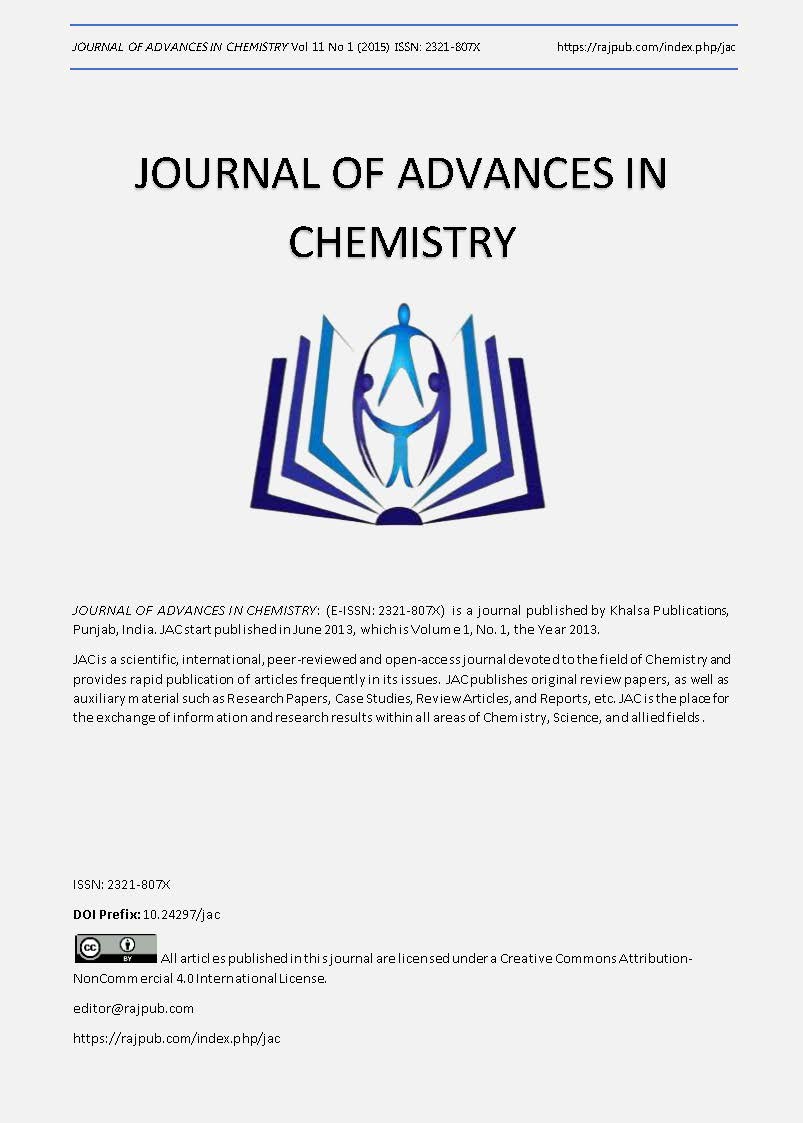Removal of BTEX from aqueous solutions by paper mill sludge-based activated carbon
DOI:
https://doi.org/10.24297/jac.v11i1.6688Keywords:
Removal, BTEX, Adsorption, Paper mill sludge-based activated carbon, GroundwaterAbstract
The removal of BTEX (benzene, toluene, ethyl-benzene and p-xylene) from contaminated groundwater was evaluated by paper mill sludge-based activated carbon, prepared by chemical activation and pyrolysis.The effects of pH, time, adsorbent dosage and adsorbate concentration were studied through batch adsorption experiments. Selected physical and chemical characteristics of the adsorbents, such as specific surface area (613m2/g), pore volume distribution (micropore: 277cm3/g, mesopore: 365cm3/g) and surface functional groups (carboxylic, alkyl and aliphatic groups) were determined by N2 adsorption-desorption diagram and FTIR, respectively. The removal efficiency of the four target compounds would be more than 92 %, which the initial concentrations of BTEX and the adsorbent dosage were 40 mg/l and 1000 mg/l, respectively. It was proved that pH and ionic strength have insignificant effects on the adsorption efficiency. The order of adsorption amount in all experiments was > ethyl-benzene > toluene > benzene. The kinetic data proved a closer fit to the pseudo-first-order model. The isotherm experimental data showed a better fit to either Freundlich or Langmuir model. In addition, a series of experiments was conducted to evaluate the capacity of the adsorbent in adsorbing the BTEX from a groundwater sample contaminated with gasoline.
Downloads
References
[2] Aivalioti, M., Papoulias, P., Kousaiti, A., Gidarakos, E. (2012) Adsorption of BTEX, MTBE and TAME on natural and modified diatomite, Journal of Hazardous Materials Volumes 207–208, 117–127
[3] Wilbur, S. and Bosch, S. (2004) Interaction Profile for: Benzene, Toluene, Ethylbenzene, and Xylenes (BTEX), Agency for Toxic Substances and Disease Registry, US Department of Health and Human Services Public Health Service, Atlanta, GA, 2004.
[4] World Health Organization, (2008) Guidelines for Drinking-water Quality (3rd ed.), Vol. 1, World Health Organization, Geneva, 2008.
[5] Yang, R. T. (2003) Adsorbents: fundamentals and applications, John Wiley & Sons, Inc.
[6] Wang, L. K., Hung, Y. T., Shammas, N. K. (editors), (2006) Advanced Phisycochemical Treatment Processes, Humana Press, Chapter 4.
[7] Bansal, R. C. and Goyal, M. (2005) Activated Carbon Adsorption, CRC Press Taylor & Francis Group
[8] Ren, X., Chen, C., Nagatsu, M., Wang, X. (2011) Carbon nanotubes as adsorbents in environmental pollution management: A review, Chemical Engineering Journal 170 395–410
[9] Nourmoradi, H., Nikaeena, M., Khiadani, M. (2012) Removal of benzene, toluene, ethylbenzene and xylene (BTEX) from aqueous solutions by montmorillonite modified with nonionic surfactant: Equilibrium, kinetic and thermodynamic study, Chemical Engineering Journal 191 341– 348
[10] Torabian, A., Kazemian, H., Seifi, L., NabiBidhendi, H., Azimi, A. A., Ghadiri, S. K. (2010) Removal of Petroleum Aromatic Hydrocarbons by Surfactant-modified Natural Zeolite: The Effect of Surfactant, Clean 38(1), 77–83
[11] Demirbas, A. (2009) Agricultural based activated carbons for the removal of dyes from aqueous solutions: A review, Journal of Hazardous Materials 167 1–9
[12] Ahmaruzzaman, M. (2011) Industrial wastes as low-cost potential adsorbents for the treatment of wastewater laden with heavy metals, Advances in Colloid and Interface Science 166 36–59
[13] Smith, K.M., Fowler, G.D., Pullket, S., Graham, N.J.D. (2009) Sewage sludge-based adsorbents: A review of their production, properties and use in water treatment applications, water r ese arch 43 2569–2594
[14] Calace, N., Nardi, E., Petronio, B. M., Pietroletti, M. (2002) Adsorption of phenols by papermillsludges, Environmental Pollution 118 315–319
[15] Li, W., Yue, Q., Tu, P., Ma, Z., Gao, B., Li, J., Xu, X. (2011) Adsorption characteristics of dyes in columns of activated carbon prepared from paper mill sewage sludge, Chemical Engineering Journal 178 197– 203
[16] Bhatnagar, A., Sillanpää, M., (2010) Utilization of agro-industrial and municipal waste materials as potential adsorbents for water treatment—A review, Chemical Engineering Journal 157 277–296
[17] USEPA, Method 8260B Volatile Organic Compounds by Gas Chromatography/Mass Spectrometry (GC/MS),US Environmental Protection Agency, Washington DC, 1996.
[18] USEPA, Method 5035 Closed-system Purge-and-trap and Extraction for Volatile Organics in Soil and Waste Samples, US Environmental Protection Agency, Washington DC, 1996.
[19] Khalili, N. R., Campbell, M., Sandi, G., Golas, J. (2000) Production of micro- and mesoporous activated carbon from paper mill sludge I. Effect of zinc chloride activation, Carbon 38 1905–1915
[20] YU, F., Ma, J., Wu, Y. (2011) Adsorption of toluene, ethylbenzene and xylene isomers on multi-walled carbon nanotubes oxidized by different concentration of NaOCl, Front. Environ. Sci. Engin. China 6:3 320–329
[21] Ros, A., Lillo-Ro´denas, M.A., Fuente, E., Montes-Mora´n, M.A., Martı´n, M.J., Linares-Solano, A. (2006) High surface area materials prepared from sewage sludge-based precursors, Chemosphere 65 132–140
[22] Daifullah, A.A.M., Girgis, B.S., (2003) Impact of surface characteristics of activated carbon on adsorption of BTEX, Colloids and Surfaces A: Physicochem. Eng. Aspects 214 181/193
[23] Calace, N., Nardi, E., Petronio, E. M., Pietroletti, M., Tosti, G. (2003) Metal ion removal from water by sorption on paper mill sludge, Chemosphere 51 797–803
[24] Sharmasarkar, S., Jaynes, W. F., Vance, G. F. (2000) BTEX sorption by montmorilloniteorgano-clays: TMPA, ADAM, HDTMA, Water, Air, and Soil Pollution119 257–273
[25] Edwaldz, J. K. (editor), (2011) Water Quality and Treatment, A Handbook on Drinking Water (6th edition), American Water Works Association, The McGraw-Hill Companies, Chapter 14.
[26] Koyuncu, H., Yildiz, N., Salgin, N., Köro˘glu, F., Calimli, L. (2011) Adsorption of o-, m- and p-nitrophenols onto organically modified bentonites, Journal of Hazardous Materials 185 1332–1339
[27] Wang, D., McLaughlin, E., Pfeffer, R., Lin, Y. S. (2011) Adsorption of Organic Compounds in Vapor, Liquid, and Aqueous Solution Phases on Hydrophobic Aerogels, Ind. Eng. Chem. Res., 50:21, 12177–12185
[28] Khenifi, A. Bouberka, Z., Sekrane, F., Kameche, M., Derriche, Z. (2007) Adsorption study of an industrial dye by an organic clay, Adsorption, 2007 (13) 149–158
[29] Su, F., Lu, C., Hu, S. (2010) Adsorption of benzene, toluene, ethylbenzeneandp-xylene by NaOCl-oxidized carbon nanotubes, Colloids and Surfaces A: Physicochem. Eng. Aspects 353 83–91
Downloads
Published
How to Cite
Issue
Section
License
 All articles published in Journal of Advances in Linguistics are licensed under a Creative Commons Attribution 4.0 International License.
All articles published in Journal of Advances in Linguistics are licensed under a Creative Commons Attribution 4.0 International License.




